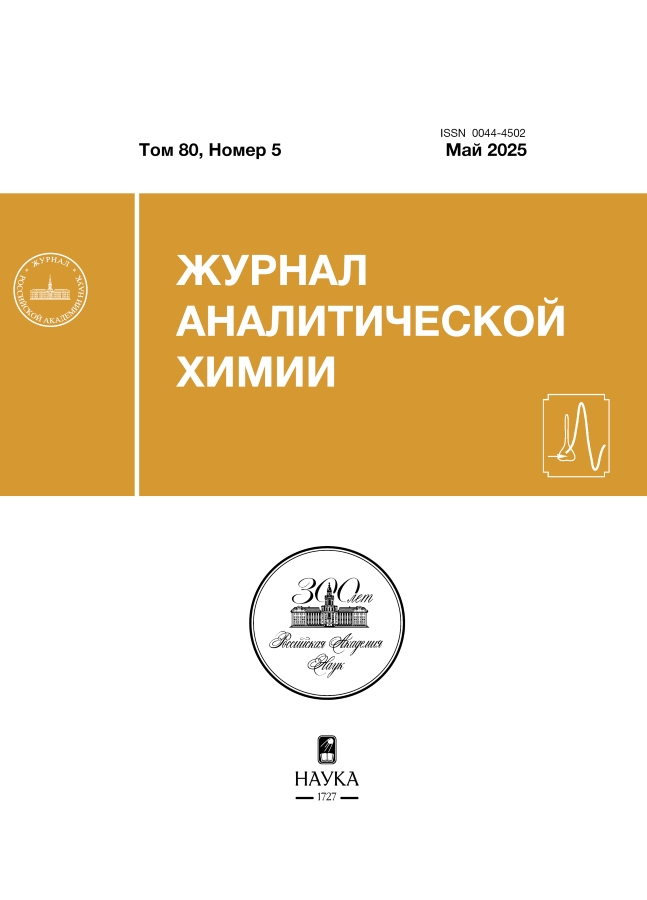Improvement of selectivity and sensitivity of tetracycline antibiotics analysis based on ESI-MS method with monoquadrupole mass analyser
- Авторлар: Streletskiy A.V.1, Antropova N.S.1
-
Мекемелер:
- Center for Strategic Planning and Management of Medical and Biological Health Risks of the Federal Medical and Biological Agency
- Шығарылым: Том 80, № 5 (2025)
- Беттер: 479-488
- Бөлім: ORIGINAL ARTICLES
- ##submission.dateSubmitted##: 20.06.2025
- ##submission.dateAccepted##: 20.06.2025
- URL: https://kazanmedjournal.ru/0044-4502/article/view/685431
- DOI: https://doi.org/10.31857/S0044450225050041
- EDN: https://elibrary.ru/athbkk
- ID: 685431
Дәйексөз келтіру
Аннотация
Methodological approaches that can be applied to improve the metrological characteristics of a monoquadrupole mass analyser for the study of residual content of small organic substances in aqueous media on the example of tetracycline antibiotics are described. To improve the selectivity of the analysis it is suggested to use optimal parameters of electron optics in the source (voltage at the fragmentor) in order to achieve high yield of ion-products. It is shown that the sensitivity of the analysis can be improved by summing the signals of all formed ion-products.
Негізгі сөздер
Толық мәтін
Авторлар туралы
A. Streletskiy
Center for Strategic Planning and Management of Medical and Biological Health Risks of the Federal Medical and Biological Agency
Хат алмасуға жауапты Автор.
Email: AStreletsky@cspfmba.ru
Ресей, Moscow
N. Antropova
Center for Strategic Planning and Management of Medical and Biological Health Risks of the Federal Medical and Biological Agency
Email: AStreletsky@cspfmba.ru
Ресей, Moscow
Әдебиет тізімі
- Kumirska J. Special Issue “Pharmaceutical Residues in the Environment” // Molecules. 2020. V. 25. № 12. P. 2941.
- Gago-Ferrero P., Bletsou A.A., Damalas D.E., Aalizadeh R., Alygizakis N.A., Singer H.P. et al. Wide-scope target screening of >2000 emerging contaminants in wastewater samples with UPLC-Q-ToF-HRMS/MS and smart evaluation of its performance through the validation of 195 selected representative analytes // J. Hazard Mater. 2020. V. 387. Article 121712.
- Ekpeghere K.I., Sim W.-J., Lee H.-J., Oh J.-E. Occurrence and distribution of carbamazepine, nicotine, estrogenic compounds, and their transformation products in wastewater from various treatment plants and the aquatic environment // Sci. Total Environ. 2018. V. 640–641. P. 1015.
- The Encyclopedia of Mass Spectrometry: V. 1: Theory and Ion Chemistry. / Eds. M.L. Gross, P.B. Armentrout, R.M. Caprioli. Oxford: Elsevier Science, 2003. 924 p.
- Bernardo-Bermejo S., Xue J., Hoang L., Billings E., Webb B., Honders M.W. et al. Quantitative multiple fragment monitoring with enhanced in-source fragmentation/annotation mass spectrometry: 4 // Nat. Protoc. 2023. V. 18. № 4. P. 1296.
- Xue J., Derks R.J.E., Webb B., Billings E.M., Aisporna A., Giera M., Siuzdak G. Single quadrupole multiple fragment ion monitoring quantitative mass spectrometry // Anal. Chem. 2021. V. 93. № 31. P. 10879.
- Xue J., Domingo-Almenara X., Guijas C., Palermo A., Rinschen M.M., Isbell J. et al. Enhanced in-source fragmentation annotation enables novel data independent acquisition and autonomous METLIN molecular identification // Anal. Chem. 2020. V. 92. № 8. P. 6051.
- Мирошникова А.В., Мирошникова Е.П., Аринжанова А.Т., Килякова Ю.В. Применение антибиотиков в сельском хозяйстве и альтернативы их использования // Аграраный научный журнал. 2021. № 5. С.65.
- Парамонов С.Г., Зеликова Д.Д., Склярова Л.В., Алхутова И.М. Экологические риски при микрозагрязнениях тетрациклином окружающей среды // Формулы фармации. 2022. Т. 4. № 1. С. 76.
- Ahmad F., Zhu D., Sun J. Environmental fate of tetracycline antibiotics: degradation pathway mechanisms, challenges, and perspectives // Environ. Sci. Eur. 2021. V. 33. № 1. P. 64.
- Daghrir R., Drogui P. Tetracycline antibiotics in the environment: A review // Environ. Chem. Lett. 2013. V. 11. № 3. P. 209.
- Koleva Y., Dimova T., Angelova G. Possible adverse effects of tetracyclines on the human health and the environment // Agric. Sci. Technol. 2014. V. 6. № 1. P. 86.
- ГОСТ 31694-2012. Продукты пищевые, продовольственное сырье. Метод определения остаточного содержания антибиотиков тетрациклиновой группы с помощью высокоэффективной жидкостной хроматографии с масс-спектрометрическим детектором. М.: Стандартинформ, 2013. 23 с.
- Method 1694: Pharmaceuticals and personal care products in water, soil, sediment, and biosolids by HPLC/MS/MS U.S. Environmental Protection Agency USEPA, Washington, DC, EPA-821-R-08-008, 2007. 77 p.
- Мильман Б.Л., Журкович И.К. Обобщенные критерии идентификации химических соединений методами хроматографии – масс-спектрометрии // Аналитика и контроль. 2020. Т. 24. № 3. С. 164.
- Seifrtová M., Nováková L., Lino C., Pena A., Solich P. An overview of analytical methodologies for the determination of antibiotics in environmental waters // Anal. Chim. Acta. 2009. V. 649. № 2. P. 158.
Қосымша файлдар
















